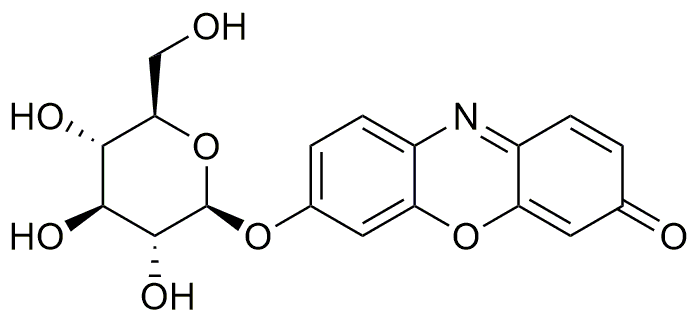Resorufin b-D-glucopyranoside is widely utilized in research focused on:
- Biochemical Assays: This compound serves as a fluorescent substrate in various enzymatic assays, particularly for measuring the activity of β-glucosidases. Its fluorescence allows for sensitive detection, making it valuable in both academic and industrial laboratories.
- Cell Viability Studies: It is used in cell culture experiments to assess cell health and proliferation. The conversion of resorufin from its non-fluorescent precursor provides a straightforward method for evaluating cytotoxicity and cell viability.
- Drug Discovery: In pharmaceutical research, it aids in screening for potential drug candidates by evaluating their effects on specific enzymes. This application is crucial for identifying compounds that can modulate biological pathways effectively.
- Environmental Monitoring: The compound can be employed in assays to detect glucosidase activity in environmental samples, helping researchers monitor soil health and microbial activity, which is essential for ecological studies.
- Diagnostic Applications: Resorufin b-D-glucopyranoside has potential uses in clinical diagnostics, particularly in tests that require the detection of specific enzyme activities related to various diseases, enhancing the accuracy of diagnostic procedures.
Información general
Propiedades
Seguridad y normativas
Aplicaciones
Resorufin b-D-glucopyranoside is widely utilized in research focused on:
- Biochemical Assays: This compound serves as a fluorescent substrate in various enzymatic assays, particularly for measuring the activity of β-glucosidases. Its fluorescence allows for sensitive detection, making it valuable in both academic and industrial laboratories.
- Cell Viability Studies: It is used in cell culture experiments to assess cell health and proliferation. The conversion of resorufin from its non-fluorescent precursor provides a straightforward method for evaluating cytotoxicity and cell viability.
- Drug Discovery: In pharmaceutical research, it aids in screening for potential drug candidates by evaluating their effects on specific enzymes. This application is crucial for identifying compounds that can modulate biological pathways effectively.
- Environmental Monitoring: The compound can be employed in assays to detect glucosidase activity in environmental samples, helping researchers monitor soil health and microbial activity, which is essential for ecological studies.
- Diagnostic Applications: Resorufin b-D-glucopyranoside has potential uses in clinical diagnostics, particularly in tests that require the detection of specific enzyme activities related to various diseases, enhancing the accuracy of diagnostic procedures.
Documentos
Hojas de datos de seguridad (HDS)
La SDS proporciona información de seguridad completa sobre la manipulación, el almacenamiento y la eliminación del producto.
Especificación del producto (PS)
La PS proporciona un desglose completo de las propiedades del producto, incluida la composición química, el estado físico, la pureza y los requisitos de almacenamiento. También detalla los rangos de calidad aceptables y las aplicaciones previstas del producto.
Certificados de análisis (COA)
Busque certificados de análisis (COA) ingresando el número de lote del producto. Los números de lote y de partida se pueden encontrar en la etiqueta de un producto después de las palabras "Lote" o "Lote".
Número de catálogo
Número de lote/lote
Certificados de origen (COO)
Este certificado de origen confirma el país en el que se fabricó el producto y también detalla los materiales y componentes utilizados en él y si se deriva de fuentes naturales, sintéticas u otras fuentes específicas. Este certificado puede ser necesario para cumplir con las normativas aduaneras, comerciales y regulatorias.
Número de catálogo
Número de lote/lote
Hojas de datos de seguridad (HDS)
La SDS proporciona información de seguridad completa sobre la manipulación, el almacenamiento y la eliminación del producto.
DownloadEspecificación del producto (PS)
La PS proporciona un desglose completo de las propiedades del producto, incluida la composición química, el estado físico, la pureza y los requisitos de almacenamiento. También detalla los rangos de calidad aceptables y las aplicaciones previstas del producto.
DownloadCertificados de análisis (COA)
Busque certificados de análisis (COA) ingresando el número de lote del producto. Los números de lote y de partida se pueden encontrar en la etiqueta de un producto después de las palabras "Lote" o "Lote".
Número de catálogo
Número de lote/lote
Certificados de origen (COO)
Este certificado de origen confirma el país en el que se fabricó el producto y también detalla los materiales y componentes utilizados en él y si se deriva de fuentes naturales, sintéticas u otras fuentes específicas. Este certificado puede ser necesario para cumplir con las normativas aduaneras, comerciales y regulatorias.


